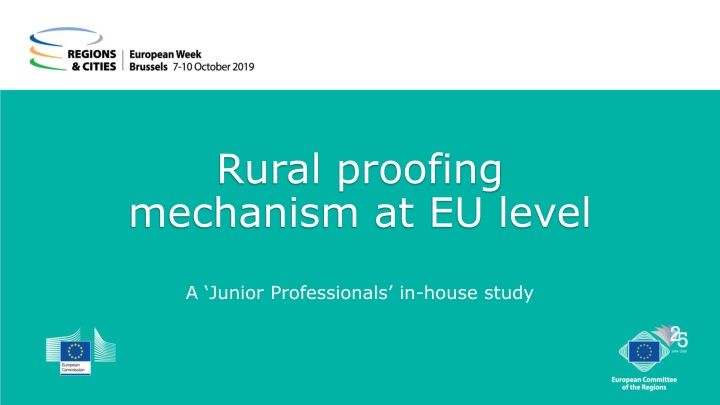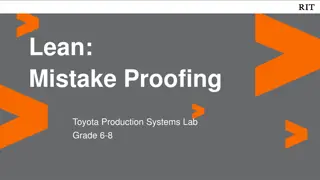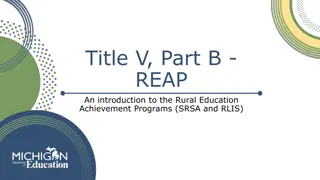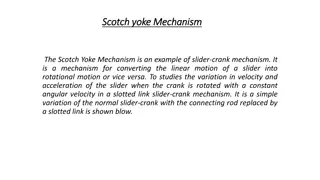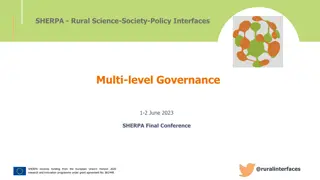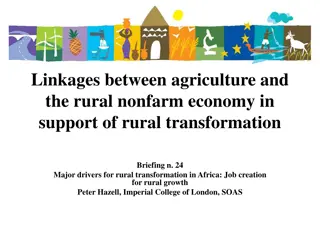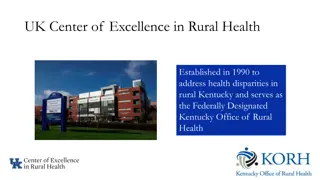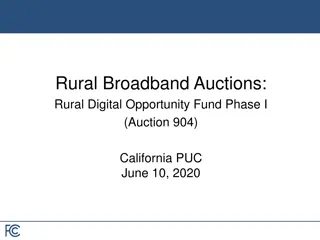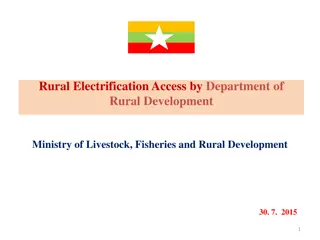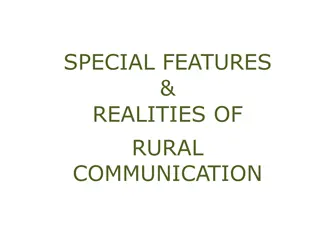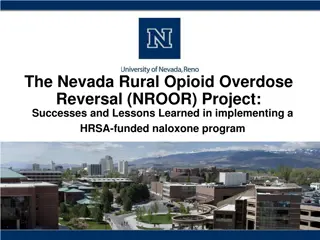Rural Proofing Mechanism at EU Level for Junior Professionals
This study delves into the process of rural proofing at the EU level, specifically focusing on the role of junior professionals in-house. The study aims to analyze how policies and initiatives are developed and implemented to ensure the inclusion and prioritization of rural areas. By examining the mechanisms in place, this study provides insights into enhancing rural development strategies and advocating for the needs of rural communities within the broader European context.
Download Presentation

Please find below an Image/Link to download the presentation.
The content on the website is provided AS IS for your information and personal use only. It may not be sold, licensed, or shared on other websites without obtaining consent from the author.If you encounter any issues during the download, it is possible that the publisher has removed the file from their server.
You are allowed to download the files provided on this website for personal or commercial use, subject to the condition that they are used lawfully. All files are the property of their respective owners.
The content on the website is provided AS IS for your information and personal use only. It may not be sold, licensed, or shared on other websites without obtaining consent from the author.
E N D
Presentation Transcript
Rural proofing mechanism at EU level A Junior Professionals in-house study
Agenda 1. Project background & methodology 2. Rural proofing: definition, benefits & context 3. State of play & constraints of rural proofing 4. Recommendations 5. Conclusion & long-term vision
Project background and methodology Team: four Junior Professionals with varied academic and professional backgrounds, Framework: independent in-house study, sponsored by DG AGRI Director for Rural Development Deliverable: concise 15-page report with recommendations on rural proofing mechanisms in the European Commission Methodology: independent analysis meetings with Commission colleagues & stakeholder +
What is rural proofing? Rural proofing means to systematically review other macro and sectoral policies through a rural lens , considering potential, and actual, impacts and implications on rural jobs and growth, development prospects, social well-being, and the environmental quality of rural areas and communities
Why is rural proofing important? Rural prosperity is crucial for the well-being and cohesiveness of the EU Without rural proofing, specificities of rural areas might be overlooked by other policy departments Rural proofing can help close urban/rural divides by avoiding adverse policy impacts in rural areas creating opportunities for rural areas and communities no citizen (and territory) should be left behind!
Context Rural proofing mechanisms exist in several EU Member States Art.174 TFEU: particular attention to be paid to rural areas in EU cohesion policy Cork 2.0 Declaration: rural proofing as a means of increasing prosperity Communication on the Future of Food and Farming: commitment to promote a rural proofing mechanism New Commission emphasises the importance of rural areas
Rural proofing in the European Commission state of play Rural proofing is generally carried out on an ad hoc basis: At interservice groups and consultations Limited cooperation and checks at early stage Some tools already exist to help implement rural proofing: Broadband rural proof test and Territorial Impact Assessment
Constraints of a rural proofing mechanism Need for political commitment and collaboration among DGs Need to avoid red tape only relevant initiatives should be scrutinised Data limitations complicate the evaluation of territorially differentiated policy impacts High share of EU funding already spent in rural areas via CAP do rural areas already receive enough attention from the EU?
Recommendations 1. Place rural proofing at the core of the long-term vision for rural areas 2. Set up a Rural Proofing Secretariat to coordinate rural proofing across Commission services 3. Promote and encourage the (proportional) use of Territorial Impact Assessments 4. Create and maintain synergies between the EAFRD and other EU funds active in rural areas 5. Make better use of the European Semester as a key policy instrument to implement rural proofing 6. Increase the number of multi-funded CLLD strategies in rural areas 7. Continue building an evidence base for rural and territorial development Political commitment Coordination structure Continuous rural proofing of Commission initiatives Tailor-made rural proofing of key policy processes Strengthening the evidence base for rural proofing
1. Place rural proofing at the core of the long-term vision for rural areas DG AGRI is tasked with developing a long-term vision for rural areas, coordinated by new Vice-President for Democracy and Demography Rural proofing should play a central role in achieving this vision There should be a strong political commitment to the use of rural proofing across Commission services
2. Set up a Rural Proofing Secretariat to coordinate rural proofing across Commission services Improve collaboration between DGs essential for successful rural proofing Develop, coordinate and oversee the implementation of a rural proofing work programme
3. Promote and encourage the proportional use of Territorial Impact Assessments Check policy initiatives in the Commission Work Programme for rural and territorial dimension Judge whether a TIA is necessary and brings real value Use at an early stage and only when particularly relevant and necessary
4. Create synergies between EU funds in rural areas Scrutinise draft CAP strategic plans for: sufficient coordination between EU funds at Member State level an approach that maximises synergies and avoids funding gaps Develop a common approach for reporting on complementarities of EU spending
5. Make better use of the European Semester Rural perspective in European Semester country reports More active role of DG AGRI in European Semester process Particular attention to cohesion policy mid-term review ESIF Partnership Agreements should take into account the rural elements highlighted in Annex D of 2019 country reports
6. Increase the number of multi-funded rural CLLD strategies Set up a joint technical assistance contract to help interested managing authorities establish a framework that enables and promotes multi-funded CLLD strategies Further explore the idea of a CLLD regulation and CLLD reserve fund in the medium- to long-term (post-2027)
7. Continue building an evidence base for rural development Bring together available data building on existing tools Develop new subnational and spatially differentiated indicators Enhance the shared understanding of different territorial and rural definitions Carry out a foresight project on Rural Areas 2040 in cooperation with relevant Commission services
Conclusion and long-term vision In order to implement rural proofing, the Commission should step up efforts and follow through on our recommendations Our rural proofing work programme: political commitment, coordination structure, improve existing proofing mechanisms, attention to key policy processes, evidence base Our vision: a more integrated, place sensitive and cross-sectoral approach to rural development
Thank you for your attention! Any questions? Giulia Filippeschi (ECFIN, BUDG, EMPL) Angelo Cozzi (SG/SRSS, ENER, IAS) Johannes B rmann Eoghan Kinirons (RTD, ECHO, TAXUD) (JUST, EAC, HOME)
